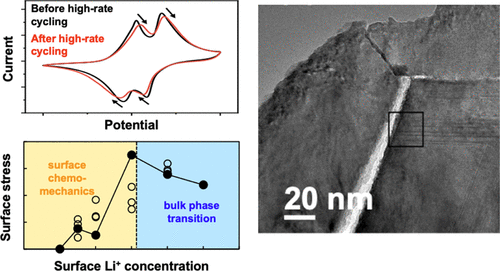当前位置:
X-MOL 学术
›
ACS Appl. Mater. Interfaces
›
论文详情
Our official English website, www.x-mol.net, welcomes your
feedback! (Note: you will need to create a separate account there.)
Oriented LiMn2O4 Particle Fracture from Delithiation-Driven Surface Stress
ACS Applied Materials & Interfaces ( IF 8.3 ) Pub Date : 2020-09-25 , DOI: 10.1021/acsami.0c13305
Robert E. Warburton 1 , Fernando C. Castro 2 , Siddharth Deshpande 1 , Kenneth E. Madsen 3 , Kimberly L. Bassett 3 , Roberto dos Reis 2, 4 , Andrew A. Gewirth 3 , Vinayak P. Dravid 2, 4 , Jeffrey Greeley 1
ACS Applied Materials & Interfaces ( IF 8.3 ) Pub Date : 2020-09-25 , DOI: 10.1021/acsami.0c13305
Robert E. Warburton 1 , Fernando C. Castro 2 , Siddharth Deshpande 1 , Kenneth E. Madsen 3 , Kimberly L. Bassett 3 , Roberto dos Reis 2, 4 , Andrew A. Gewirth 3 , Vinayak P. Dravid 2, 4 , Jeffrey Greeley 1
Affiliation

|
The insertion and removal of Li+ ions into Li-ion battery electrodes can lead to severe mechanical fatigue because of the repeated expansion and compression of the host lattice during electrochemical cycling. In particular, the lithium manganese oxide spinel (LiMn2O4, LMO) experiences a significant surface stress contribution to electrode chemomechanics upon delithiation that is asynchronous with the potentials where bulk phase transitions occur. In this work, we probe the stress evolution and resulting mechanical fracture from LMO delithation using an integrated approach consisting of cyclic voltammetry, electron microscopy, and density functional theory (DFT) calculations. High-rate electrochemical cycling is used to exacerbate the mechanical deficiencies of the LMO electrode and demonstrates that mechanical degradation leads to slowing of delithiation and lithiation kinetics. These observations are further supported through the identification of significant fracturing in LMO using scanning electron microscopy. DFT calculations are used to model the mechanical response of LMO surfaces to electrochemical delithiation and suggest that particle fracture is unlikely in the [001] direction because of tensile stresses from delithiation near the (001) surface. Transmission electron microscopy and electron backscatter diffraction of the as-cycled LMO particles further support the computational analyses, indicating that particle fracture instead tends to preferentially occur along the {111} planes. This joint computational and experimental analysis provides molecular-level details of the chemomechanical response of the LMO electrode to electrochemical delithiation and how surface stresses may lead to particle fracture in Li-ion battery electrodes.
中文翻译:

消除驱动表面应力导致取向的LiMn 2 O 4颗粒断裂
Li +离子在锂离子电池电极中的插入和去除会导致严重的机械疲劳,这是因为在电化学循环过程中主体晶格反复膨胀和压缩。特别是锂锰氧化物尖晶石(LiMn 2 O 4(LMO)在脱锂时经历了对电极化学机械的显着表面应力贡献,这与发生本体相变的电势不同步。在这项工作中,我们使用由循环伏安法,电子显微镜和密度泛函理论(DFT)计算组成的集成方法,探究了LMO脱石引起的应力演化和机械断裂。高速电化学循环用于加剧LMO电极的机械缺陷,并证明机械降解会导致脱锂和锂动力学降低。通过使用扫描电子显微镜鉴定LMO中的重大裂缝,进一步支持了这些观察结果。DFT计算用于对LMO表面对电化学脱锂的机械响应进行建模,并表明在[001]方向上粒子破裂不太可能,这是由于(001)表面附近脱锂引起的拉应力。循环中的LMO粒子的透射电子显微镜和电子背散射衍射进一步支持了计算分析,表明粒子破裂反而倾向于优先沿{111}平面发生。这项联合的计算和实验分析提供了LMO电极对电化学脱锂的化学机械响应以及表面应力如何导致锂离子电池电极中颗粒破裂的分子水平详细信息。
更新日期:2020-10-29
中文翻译:

消除驱动表面应力导致取向的LiMn 2 O 4颗粒断裂
Li +离子在锂离子电池电极中的插入和去除会导致严重的机械疲劳,这是因为在电化学循环过程中主体晶格反复膨胀和压缩。特别是锂锰氧化物尖晶石(LiMn 2 O 4(LMO)在脱锂时经历了对电极化学机械的显着表面应力贡献,这与发生本体相变的电势不同步。在这项工作中,我们使用由循环伏安法,电子显微镜和密度泛函理论(DFT)计算组成的集成方法,探究了LMO脱石引起的应力演化和机械断裂。高速电化学循环用于加剧LMO电极的机械缺陷,并证明机械降解会导致脱锂和锂动力学降低。通过使用扫描电子显微镜鉴定LMO中的重大裂缝,进一步支持了这些观察结果。DFT计算用于对LMO表面对电化学脱锂的机械响应进行建模,并表明在[001]方向上粒子破裂不太可能,这是由于(001)表面附近脱锂引起的拉应力。循环中的LMO粒子的透射电子显微镜和电子背散射衍射进一步支持了计算分析,表明粒子破裂反而倾向于优先沿{111}平面发生。这项联合的计算和实验分析提供了LMO电极对电化学脱锂的化学机械响应以及表面应力如何导致锂离子电池电极中颗粒破裂的分子水平详细信息。

































 京公网安备 11010802027423号
京公网安备 11010802027423号